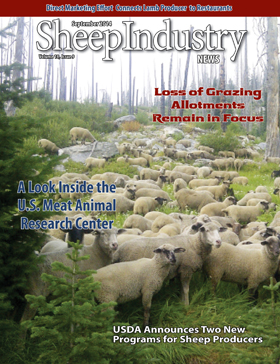
- September 2014
- President’s Notes
- Market Report
- Commentary: Stand Against Activist Organizations
- Direct Marketing: Watson’s Direct Marketing Approach Includes ‘Custom Growing’ Lambs for Fine Restaurants
- Easycare Sheep and Elimination of OPP Focus of U.S. Meat Animal Research Center
- Listening Sessions Invoke Support for U.S. Sheep Experiment Station
- Loss of Grazing Allotments Remain in Focus
- Undersecretary Visits ASI Office to Announce Programs That Will Benefit Sheep Producers
- Washington Rancher Allowed to Defend Flock in Wake of Wolf Attacks
- News Briefs
 Watson’s Direct Marketing Approach Includes ‘Custom Growing’ Lambs for Fine Restaurants
Watson’s Direct Marketing Approach Includes ‘Custom Growing’ Lambs for Fine Restaurants
It was during a disappointing lamb sale that Don Watson changed gears and decided to take the direct marketing route. Today he provides lamb to some of northern California’s finest restaurants and markets.
Watson and his wife Carolyn reside in Colorado, but a flock of East Friesian sheep that graze in California and states in between. While they are breeding custom lambs for dinner tables and milk for dairies, the Watson’s’ third enterprise is a weeding service for Napa Valley vineyards – an enterprise that seems like a natural fit, since sheep, in general, like grape vines and won’t eat the cluster of grapes.
But it’s Watson’s lamb operation that is catching attention for its direct marketing efforts. It’s the kind of approach the American Lamb Board is encouraging with its latest focus on direct marketing. ALB recently commissioned a study to better understand direct and non-traditional lamb marketing and to assess the needs of what has become a growing sector in the industry. The goal is to develop tools for producers to take advantage of direct marketing opportunities.
Watson previously spent time in Australia and New Zealand and learned about new processes. “Lambs in the U.S. are typically put into feed lots, which puts more weight on them,” he said. “But bigger, better, faster is not as good for lamb as it is for other livestock.”
It was the bottom line that motivated Watson to direct market his lambs.
“We got started when our lambs went to a sale in a $.90 market, and we were offered less than $.65,” he recalled. “I stood up and told the auctioneer not to sell them, and immediately went to work finding direct market buyers for them.”
Watson, who splits his time between the Rocky Mountain region and California, said his approach to direct marketing of his lambs is all about timing and meeting the needs of his customers.
“The north coast of California and the Willamette Valley of Oregon finish lambs at the same time every year in May,” he explained. “The feeder lamb market gets flush with inventory, and the price falls. In order to protect ourselves from this market saturation, we developed a specialty product. We now harvest lambs every week of the year.”
Watson’s first customer was Cindy Pawlcyn of Mustards Grill and Fog City Diner in Yountville, Calif. Soonafter, he added Alice Waters of Chez Panisse in Berkeley, Calif.
“Jean Pierre was the chef at Chez Panisse at the time, and he explained exactly what he wanted. He said, ‘Don can you grow them a little smaller.’ I was thinking that they were small before they got big. We always have lots of small lambs. So we grow a unique lamb for each of these great chefs, and their menus have introduced us to countless other opportunities.”
When direct marketing to restaurants, Watson noted, the most important concept to understand is that each chef has a unique vision. A producer needs to grow the lamb to meet the desires of the chef.
“We sell a 30-pound carcass to some chefs, and a 50-pound carcass to others,” Watson said. “We also sell mutton. Every animal is hand selected for the restaurant. We take orders every week of the year.”
As a custom lamb growers, Watson believes that he is in the flavor and texture business. Can he grow a lamb that explodes with flavor, and is so tender that eating it is remarkable?
Yes, Watson says.
“All of us can grow this lamb – the secret is finding the sweet spot for your operation. Ours comes from a hybrid sheep that is well suited for our region,” he adds.
Watson started with a Dorset X East Friesian ewe. He crosses it with Tom and Karen Watson’s Silverdale, or Wes and Jane Patton’s Dorper – rams have been selected for generations for a large loin eye and an exceptional leg.
“Our ewes produce a huge milk supply,” Watson says. “This gets our lambs up to 100 pounds well before they are six months old. The conformation of the carcass is stout from the day they are born and can be harvested whenever the chef says they are ready.”
So far, Watson has found success with his direct marketing and custom lamb growing operation –not that it’s without challenges.
“The greatest challenge for us is that we do not own any land,” he says. “This forced us into being creative about where we graze. This year, we have grazed alfalfa fields in the Sacramento Valley; vineyards in the Napa and Sonoma valleys, islands in the San Pablo marsh; open space and parklands; and a NASCAR track. We recently started grazing a former deer farm on the high plains of Colorado.
“Whenever we come to the end of our feed, I ask God where are we going to go now? Remarkably, a crazy idea comes out of no where, and we are off on another adventure.”

